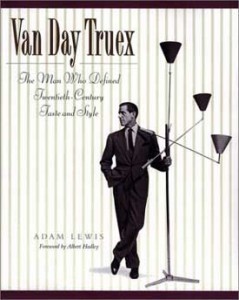Van Day Truex
Article from: cDecor.com
“I wonder if any element of interior design is more personal than color.
Nothing can more quickly reveal aspect of personality and character than the choice –
or absence of color.” Van Day Truex
 Van Day Truex. Not exactly a household name. But after reading Van Day Truex: The Man Who Defined Twentieth-Century Taste and Style by Adam Lewis one recognizes the affect this man had on the way people decorated their homes and tabletops.
Van Day Truex. Not exactly a household name. But after reading Van Day Truex: The Man Who Defined Twentieth-Century Taste and Style by Adam Lewis one recognizes the affect this man had on the way people decorated their homes and tabletops.
Truex was a poor Kansan whose aunt subsidized his trip to New York in 1923 to attend Parsons School of Design. Having been blessed with an innate sense of style and fashion, Truex learned quickly from the leading designers of the day and eventually became Parsons’ president. He also wrote columns on design for Architectural Digest in the 1970s, and was frequently cited in Vogue.
His most influential post was as design director of Tiffany’s, where he made many bold changes, such as doing away with Lenox china, introducing new patterns and reviving classic ones. His designs were based on his travels, frequent dinner invitations to some of the world’s most refined houses and research in the archives of the Metropolitan Museum of New York and the Musee des Arts Decoratifs in Paris. “At no time in his Tiffany years did anything escape Truex’s eye as a possible source for a new design,” writes Lewis. “One morning he came into the store very excited, carrying an eighteenth-century Imari plate that he had borrowed from a lady at whose table he had dined. He announced that with a few modest changes, the pattern would be perfect for Tiffany’s.”
Under Truex’s supervision, the flagship Tiffany store on Fifth Avenue was completely redecorated, with the walls painted a pale mauve (a variation of the “Truex Beige”), woven split-reed chairs and a bamboo-pattern fabric for the curtains. Today, a half-century later, the store retains Truex’s original design, a testament to his widely embraced sense of high style.
With a considerable number of pictures of Truex’s residences, his product designs and his social circle, the book contains a fascinating glimpse into the social history of the creme de la creme of the western world. Given the copious research Lewis presents, Van Day Truex can certainly be considered the definitive tastemaker of the 20th century.



